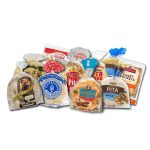How to Choose the Best Frozen Food Bags for Your Business

In today’s competitive food industry, choosing the right Frozen Food Bags can significantly impact your product quality, brand reputation, and customer satisfaction. Whether you’re operating a restaurant, commercial kitchen, or food production facility, selecting the most suitable bags for food packaging ensures your frozen goods remain fresh, protected, and appealing.
1. Understand the Demands of Frozen Storage
Frozen foods are exposed to extreme conditions, including low temperatures and potential moisture buildup. Therefore, your Frozen Food Bags must be durable enough to withstand freezing, thawing, and handling without compromising the contents. Look for multi-layer barrier films that prevent freezer burn and lock in flavor, freshness, and texture.
2. Choose the Right Material
Not all bags for food packaging are created equal. For frozen foods, materials like polyethylene (PE) and polypropylene (PP) are popular due to their flexibility, puncture resistance, and moisture barrier properties. You can also consider laminated films for added strength and better visual presentation. If sustainability matters to your brand, ask suppliers about recyclable or biodegradable options that perform well under freezing conditions.
3. Seal Strength Matters
A strong, airtight seal is essential to prevent leakage and contamination. Consider heat-sealed or zip-lock closures that offer tamper evidence and resealability. Proper sealing not only extends shelf life but also ensures your frozen products remain secure during transport and storage.
4. Size and Format Fit for Function
The size and type of bag you choose should match your product’s shape, weight, and portion size. Common formats include flat pouches, gusseted bags, and stand-up pouches. For bulk items, heavy-duty freezer bags with reinforced bottoms can improve handling efficiency. Custom sizing also helps reduce excess air in packaging, minimizing freezer burn.
5. Labeling and Custom Printing
Frozen food packaging is a powerful branding tool. Invest in Frozen Food Bags with high-quality custom printing to display your logo, product details, and nutritional information. Eye-catching designs and clear labeling enhance shelf visibility and build consumer trust. Some packaging even features frost-resistant inks and windows to show product quality.
6. Regulatory Compliance
Ensure your packaging complies with food safety standards such as FDA or USDA regulations. Your bags for food packaging should be food-grade, BPA-free, and tested for performance under freezing temperatures.
7. Consider Your End Use and Market
Whether you’re selling to wholesalers, retailers, or direct to consumers, the packaging should reflect your target market. Retail packaging demands attractive, retail-ready designs, while foodservice operations may prioritize functionality and storage efficiency.
Conclusion
Choosing the right Frozen Food Bags is not just about preserving your products—it’s about protecting your brand. By considering material quality, sealing strength, size, and branding, your business can ensure safe, efficient, and appealing packaging for every frozen item. Whether you’re scaling up production or refining your packaging line, the right bags for food packaging will make a lasting impact.




